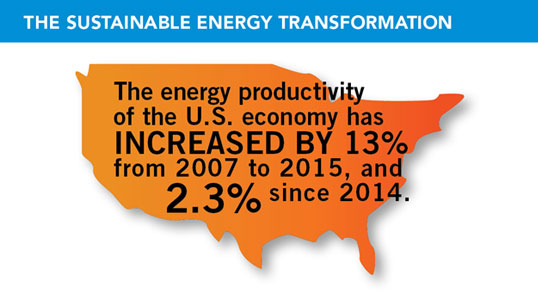The renewable energy revolution powers on in the United States

By Dr Anthony Horton
A joint report by Bloomberg New Energy Finance (BNEF) and The Business Council for Sustainable Energy (BCSE) has shown that the renewable energy revolution in the United States continues to gain momentum. This report entitled ‘2016 Sustainable Energy in America Factbook’ was released on Thursday 4 February 2016, and describes how investment in energy efficiency is paying significant dividends in the United States. According to the report, the US economy has grown 10% since 2007, with a 2.4% reduction in energy consumption during this time. Energy productivity (defined as the ratio of GDP to energy consumed) also grew by 2.3% in 2015.
This report points to a number of milestones regarding the decrease in carbon emissions from the US electricity grid in 2015, including:
- Coal-fired power plants which provided a total 14 Gigawatts (14 thousand million Watts) of power were decommissioned
- Coal represented only 34% of the total US electricity generation
- 5 Gigawatts of wind and 7.3 Gigawatts of solar photovoltaic (e.g. rooftop solar) was installed
- Corporate procurement of renewable energy continues to grow, with companies adding a further 3.1 Gigawatts of capacity. Google, Amazon, Facebook and Apple were amongst the major procurers
Reductions in carbon emissions from the electricity grid are continuing to reduce the US carbon footprint. The 2015 total of 1985Mt (1985 million tonnes) was 4.3% lower than 2014 and approximately 18% lower than 2005 levels. The Obama administration has also released a number of policies in 2015 under The Clean Power Plan, which will ensure the US keeps on track to a lower carbon electricity sector. By 2030, The Clean Power Plan aims to reduce carbon emissions by 32% through allocating each US state an emissions target (in tonnes) or emission rate (tonnes per Megawatt hour). Additionally, this plan sets emission limits on new power plants and requires new coal-fired power stations to capture and store carbon emissions.
A number of state and local Governments in the US have now also implemented policies that promote energy savings. Ten states including Texas, California and New Jersey adopted more stringent residential and commercial building codes in 2015. Approximately 8% of US commercial floor space has been covered by policies that mandate energy consumption reporting and benchmarking as of the end of 2015.
During 2015, the total US renewable energy investment was $56 billion, which represents an 8% increase from 2014. Approximately 50% of this amount was invested in solar, and 21% in wind. The 2016 Sustainable Energy report attributes this increase to project developers rushing to get projects commissioned before the expiration of Federal tax credits designed to encourage these projects.
In Texas and the Midwest, which are characteristically windier than other parts of the US, developers have signed long-term power purchase agreements at US$19-35 per Megawatt hour (MWh) – which is lower than on and off peak power prices. Developers of solar projects in Texas signed agreements at US$50 per MWh in 2015, which made those projects cost-competitive in areas with high retail electricity rates.
The milestones reported in the 2016 Sustainable Energy in America Factbook could be hints of what is to come in the US. In his final budget request on Saturday 6 February 2016, Barack Obama called on the US Congress to double funding for clean energy research to US$12.8 billion by 2020 as part of action on climate change. Funds would be sought for research into battery storage, electric cars and cleaner fuel. Obama’s call coincided with an initiative led by Bill Gates and Mark Zuckerberg to leverage more research funding from the private sector.
The budget to be announced this week on Tuesday 9 February 2016 is one of Obama’s last opportunities to guide the US environmental agenda. The efforts Obama has made to reduce the carbon emissions of the US economy may come under pressure from the Republican controlled Congress in the coming months. Congress is expected to attempt to cut the Environmental Protection Agency (EPA) budget such that the enforcement of new emissions reduction rules from power plants may be compromised.
It is clear from the 2016 Sustainable Energy report that the US continues to make significant progress in reducing carbon emissions from the electricity grid as a result of strong deliberate policies at all levels of Government. It is an example to other developed countries of what can be achieved with collaborative effort. It also shows that concerns over emissions reduction efforts jeopardising economic growth are clearly unfounded.
Although Obama’s time as President is coming to an end, I am optimistic that the gains made by the US in terms of emissions reduction during his Presidency will be built upon rather than demolished. While there are clearly differences of opinion regarding emissions reduction and climate change in the US and worldwide, I believe that the renewable energy revolution will continue to power on and be an example to other countries. The current Australian Government could certainly follow the US lead and realise the potential that strong deliberate emissions reduction policies can deliver.
 About the author: Anthony Horton holds a PhD in Environmental Science, a Bachelor of Environmental Science with Honours and a Diploma of Carbon Management. He has a track record of delivering customised solutions in Academia, Government, the Mining Industry and Consulting based on the latest wisdom and his scientific background and experience in Climate/Atmospheric Science and Air Quality. Anthony’s work has been published in internationally recognised scientific journals and presented at international and national conferences, and he is currently on the Editorial Board of the Journal Nature Environment and Pollution Technology. Anthony also blogs on his own site, The Climate Change Guy.
About the author: Anthony Horton holds a PhD in Environmental Science, a Bachelor of Environmental Science with Honours and a Diploma of Carbon Management. He has a track record of delivering customised solutions in Academia, Government, the Mining Industry and Consulting based on the latest wisdom and his scientific background and experience in Climate/Atmospheric Science and Air Quality. Anthony’s work has been published in internationally recognised scientific journals and presented at international and national conferences, and he is currently on the Editorial Board of the Journal Nature Environment and Pollution Technology. Anthony also blogs on his own site, The Climate Change Guy.









6 comments
Login here Register here-
Anthony Element -
Michael Taylor -
Wally -
Kyran -
jimhaz -
Brad
Return to home pageThe US has indeed come a long way, but it doesn’t do to underestimate the sheer bloodymindedness of the Neocons pulling the GOP strings.
Indeed, Anthony. It could all go pear shaped with a Republican’s win.
“Developers of solar projects in Texas signed agreements at US$50 per MWh in 2015”
That is a similar to the wholesale price of power generated with brown coal in Victoria, proof that deployment of large scale solar can be cost effective but we are told the opposite.
In an attempt to validate your optimism, Mr Horton, Schwarzenegger was a republican. His leadership introduced a ‘cap & trade’ emissions scheme in 2006 in California. Which, if it was a country, would be the 7th or 8th largest economy on the planet. I haven’t checked if there is a ‘Whyalla’ in California, but I’m certain no towns disappeared due to the scheme.
The treatment of the Ozone layer issue is relative, to the extent the first responder’s were the scientists, through their Antarctic research. The media, back in those days, was largely traditional ‘MSM’, ie print, tv, etc. They did cover the story and people across the globe reacted, becoming the second responders. Ironically, the third responders were businesses, who started reducing CFC componentry in all manner of things. Not surprisingly, the fourth responders were the politicians. It became the Montreal Protocol.
Looking at the ‘political’ landscape, the horizon is bleak. Politicians seem so focussed on their popularity polls, they are unlikely to see the window, let alone the horizon. Whilst the media, back in those days, did its job, ‘modern’ MSM is so focussed on its own poll’s or ratings, they don’t even put windows in their buildings. My optimism is that neither the pollie’s or their compliant MSM understand that we all talk!
Thank you, Mr Horton. Take care
Yes, we are scared of what might happen after seeing what Abbott and his Christian cheer squad did.
Fingers crossed someone at least partly rational gets in. Good to see Texas in the list. Lets also hope for the barrel price to double in the meantime. If a maddy gets in, I’d expect only one term, and that is not that hard to recover from seeing as much RE development is being driven by the individual states.
Betting markets seem to be pointing to a Clinton win.
I don’t hold much hope that our government will realise the potential of renewable energy until there is a change of government. There are too many voices in the current admin that unwittingly advocate under achievement.
Conservative politics isn’t the way forward for this country.